INFORMATION
Breaking Down Ice Fishing for Beginners- by Will Nalley
 Safety:
Safety:
The first and foremost thing we need to talk about here is safety, and that is NEVER give the ice more credit than what it is due. Make sure to have crazy amounts of caution when fishing the ice, the last thing you want is to break through and risk hypothermia. That being stated, always remember the buddy system: ice fishing is not something I suggest anyone do alone. If you do go somewhere alone, make sure there are other people in the area and you tell people where you are going. It is always a good idea to wear flotation clothing just for ice anglers, or perhaps what I do and wear a life jacket. I know they are big and bulky, but its better safe than sorry. The suggested ice thickness that everyone I know abides by is 4” to walk on, 6” for an ATV or snowmobile, and 12” for vehicles. Always have a spud with you to check the ice thickness.
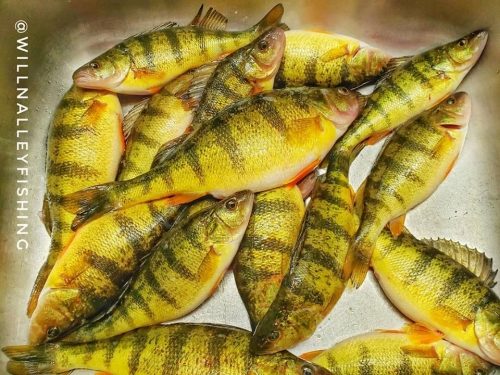
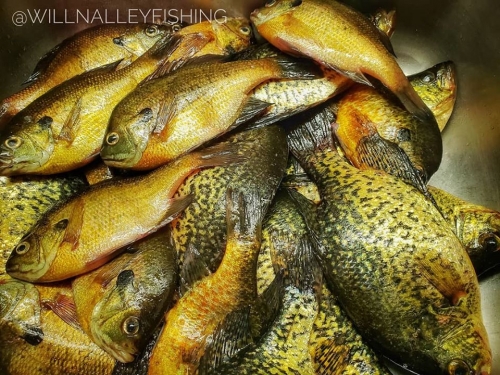
Species:
This is one of my favorite times of year to fish because the best eating fish can be caught. Those include the Panfish, Bluegills, Yellow Perch, Walleye, and Crappie. Yes, I know you will have to brave some crazy elements to make this happen; but it is well worth it when you can get on a good pile of them. This time of year; however, the fish have to eat to generate some sort of heat. So if you drill your hole around them and have a hardbait that is UV with rattles, it’s typically not hard to get them to bite.
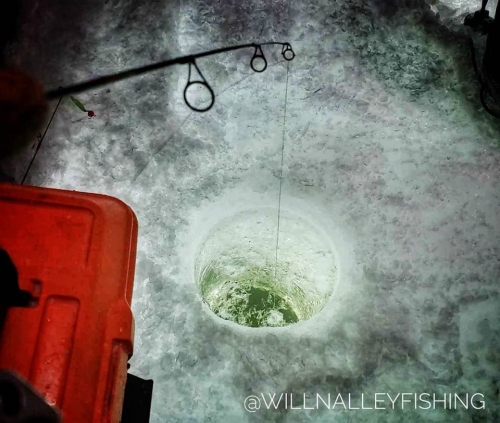
What to target:
This is where experience on the lake you are ice fishing really comes into play and so does a good depth finder and mapping system. I typically want to target some piece of structure and weed lines, and fishing the warmer months in open water is really the only way to find this. You can certainly find some solid weed lines and edges in 6-12 feet of water that are holding fish. This is because the chunk rocks in these areas hold healthier vegetation and heat, which the fish will relate to. Structure though, is where I find the better walleye and crappie. So it pays off to know the best areas of structure of transitions off flats.
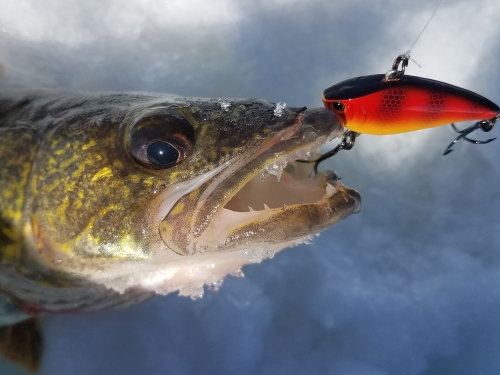
Weather conditions:
This is where it gets a little bit tricky to justify when the best times to go are, because it is always cold. As much as I hate to say it for the anglers that do not like the cold, the night time is the best time to get out there. The last few hours of daylight in the day into the dusk/night fall hours have always seemed to be the best for me. I believe this is because the moon and gravity force become less at night allowing the fish to move around a little easier in the cold conditions.
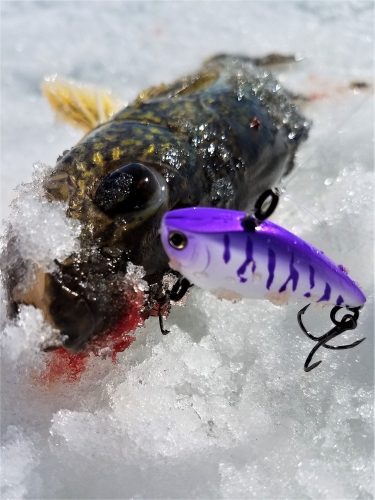
What to take with you:
Flasher/sounder/camera- a combo of a flasher and camera is pretty much all you need. I’ve found that an LCD display sonar is great for larger fish generally, as you have history on the screen which you lose when you use a flasher which provides real-time feedback on fish and lure location, but there is no history.
GPS – ideally you’ve done your homework ‘ground-truthing’ spots during open water with your boat – the GPS is also great for new spots, and finding your way to safety if you’re in whiteout condition.
Gas powered Drill with 24” bit- This is for drilling your hole to drop your flasher/ camera and fishing out of.
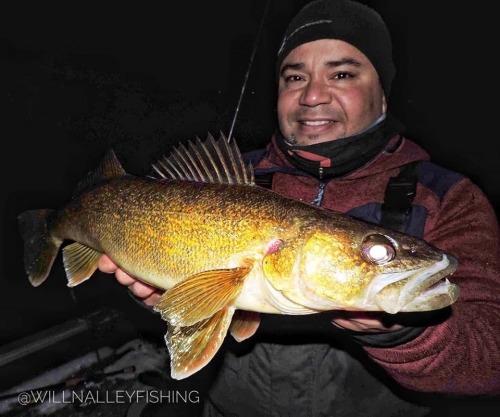
Biggest Mistakes by Beginners:
Panfish – line too thick, and lure size too big for the size of the presentation and the species target.
Larger predators – for walleyes – fishing the wrong times of the day or targeting them in water considered to be less than optimal in depth, there are always exceptions to the rule here if you have some history to go off of. Very common today for people to use a braid and fluorocarbon leader – often the fluorocarbon will be added to a swivel if you’re using a rotating presentation. Because of dropping strait down, this will create line twists. Braid can be problematic in very cold temps – if you’re in a hut, you’re in business. Larger fluorocarbon requires a larger size spool to manage the stiffness of the line.
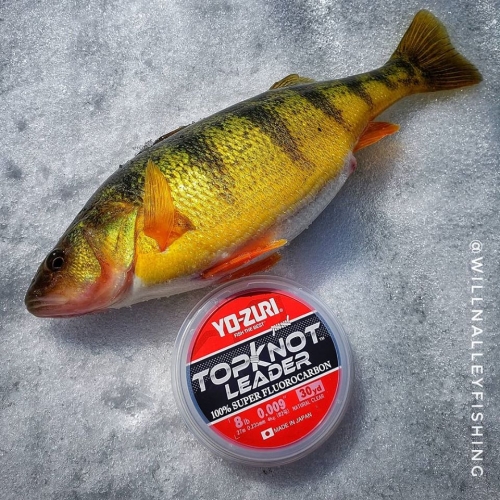
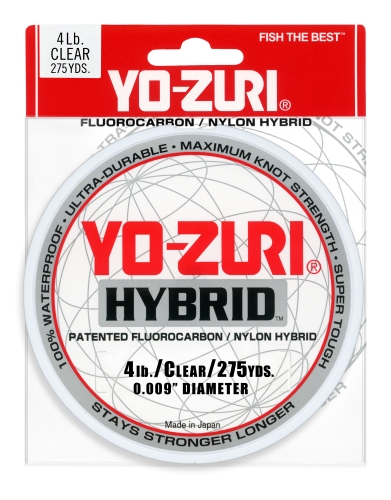
Yo-Zuri Product to Take:
-Hybrid line in 4lb test, this is definitely a style of fishing that you want the smallest diameter line you can get away with.
-8lb TopKnot Leader, this is something I like to use when fishing for bigger walleyes. I also think it helps the bait sink faster when I see a fish on my camera or flasher.
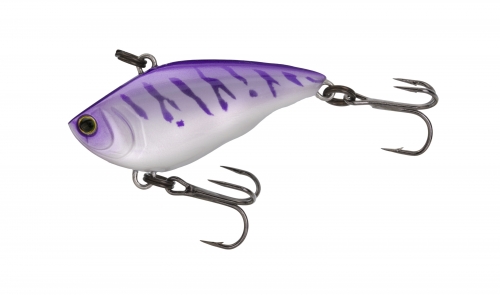
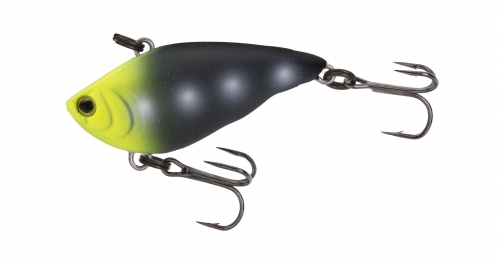
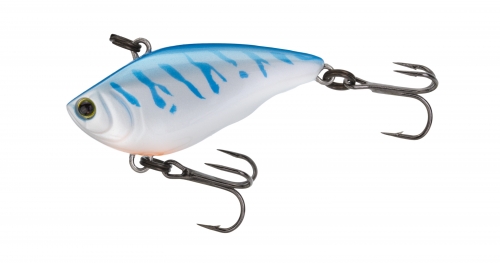
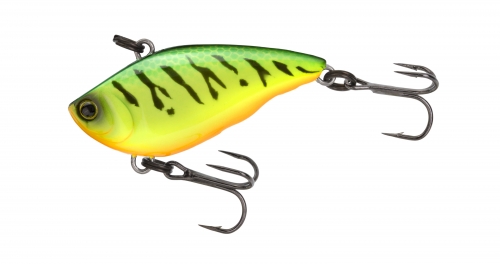
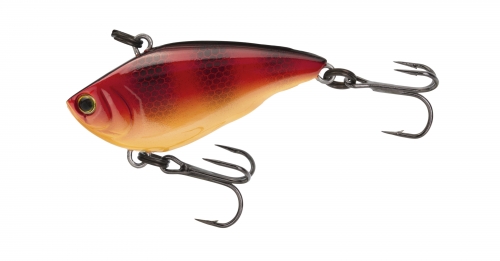
-NEW Rattl’N Vibe Mini, this is a bait designed specifically for ice fishing anglers. I definitely love the UV colors since I fish so much at night, but also my favorites are Firetiger, Gold with Black Back, and Hot Perch
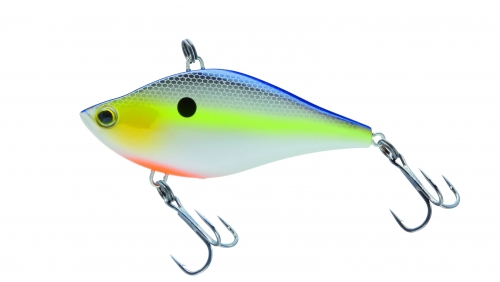
-3DS Vibe, this is a bait I catch a lot of bigger walleyes on and it seems to have a great falling action through the water column. Usually the fish eat this bait on the initial drop.
Take your Grandkids fishing with the Yo-Zuri Snap Bean – by Martha Goodfellow
Recently, I was blessed to have our two youngest grandkids come for a visit (ages five and three). They each had a week of their own, for what we teased was “Camp at the Grandparents.” One of our adventures was to go fishing at a friend’s pond. You should have seen the total delight and excitement on each of their faces as they caught one bream after another.
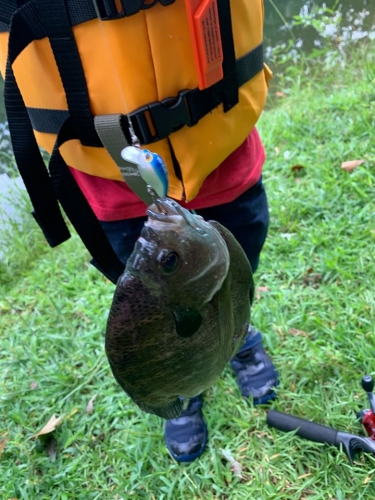
Each child had their own favorite pole and since they were the kid of the week, they could choose from several kid rods. Our grandson’s favorite was his kid spider-man pole. That pole was rigged with a Yo-Zuri Snap Bean in the silver/black back lure. Another had a silver/blue back Snap Bean. And, to mix it up a bit, we had one rigged with a plastic lure. Hands down, our five year old grandson loved using the Snap Bean. Instead of patiently waiting for a fish to find the plastic, he could slowly retrieve the Snap Bean and it kept his interest. Of course kids all have their own personalities and our 3 year old granddaughter loved using brother’s spider-man pole since he wasn’t there. J We rotated through using the Snap Bean and a plastic bait.
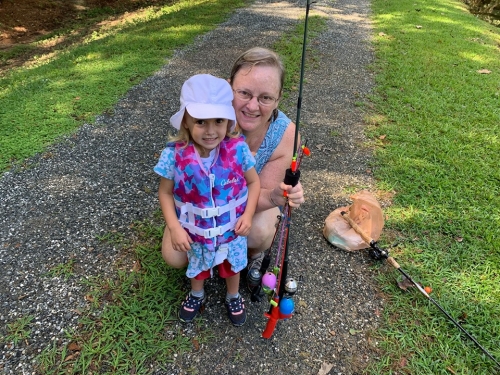
The Snap Bean worked great for the kids. Since it is a shallow diving crankbait, it stays close to the surface. The Snap Bean only weighs 1/16 oz and has one treble hook. To use on the kids poles and make it easier to get longer casts, I put a weighted bobber on the line above the lure. Using a bobber also helped the kids watch for when a fish was “playing” with their bait and for when they had a fish on.
Summer Calicos in Cali with Yo-Zuri- by Jonathan Lobaugh
Summer time is finally here in SoCal the calico bass are fired up and are in full spawn effect! Now, the only difference is calico bass are highly aggressive in spawn unlike largemouth bass where you need to entice that bite. Calicos are not like that all, find those conditions and throw only two baits! Lately my choice of poison is the Crystal Minnow 130 in many color ways however the peanut bunker has been the most deadly. The Hydro Minnow LC is also another great choice of bait. Giving its great action and tight wobble action, calicos cannot resist.
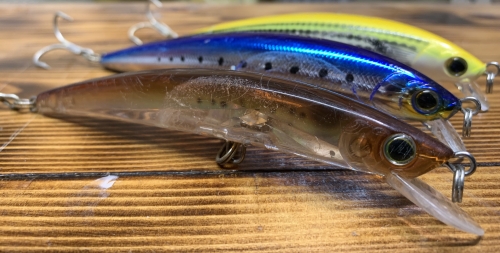
I have tried many different ways to fish these two baits and I have found that the swim with the best action when you fish a clip or straight to 25lb -30lb HD Carbon, it really all depends on your preference. I typically like fishing this bait on a conventional set up with a 7’5” heavy action rod and over-sized Shimano bait casting reel. The crystal minnow has proven to me to be the best search bait when hunting for calico bass with its incredible action and the ability to dive to 5ft deep giving it an advantage as it can run under kelp canopy’s and get down closer to the reefs when fishing up tight in the skinny water. Pick one up of each, crystal minnow, and hydro minnow.
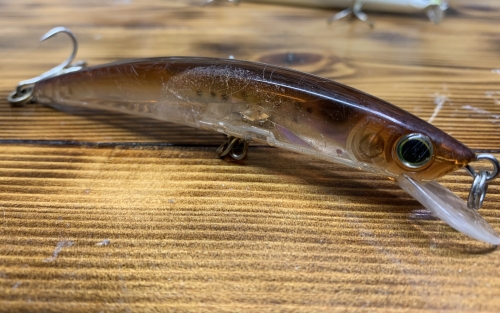
People often ask me when I choose one over the other, the truth is let the fish tell you which one they want. I have had days where I really do well on the LC Minnow and then other days that when throwing the 130 Crystal Minnow they are ripping the rod out of my hands. The key is to match the color patterns to the bait, finding the bait, and from there you should be able to locate the aggressive calicos. Once they are actively feeding near the boat you can cast your bait bait to them. Many people believe you have to troll for calicos, that is not the case at all. In some instances the big ones will be right up against the boiler rocks that are being hit by the swell. It’s always worth getting as close as is safe and lobbing some casts into that swell zone.

Throw The Knuckle For A Great Change-Up- by Mark Maule
With August rapidly approaching, many larger northern pike have retreated to deep water weeds, deeper rock piles, or roam the basin in some cases chasing schools of baitfish. During this time, many anglers put away their northern pike gear because it can be more challenging to catch bigger fish than it is during the spring and fall seasons. However, if you can find the fish, they can be caught. One of my favorite lures to fish large northern pike during late July and throughout August is the Yo-Zuri 3DB Knuckle Bait.
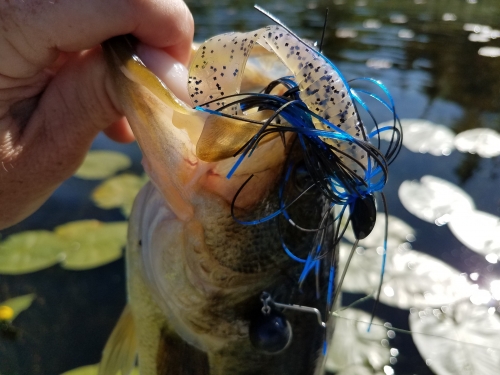
At 1/4, 1/2, and 5/8 oz. the Yo-Zuri 3DB Knuckle Bait can effectively be fished throughout the water column. The 1/4 oz. Knuckle is a perfect choice when fishing in water up to about 10’ above downed wood, right at the edge of weeds that drop into deeper water, or off of long points. The 1/2 oz. and 5/8 oz. Knuckle Baits are a great choice when fishing in water from 10-20’ deep while working the edge of weedlines and sharp drops or humps. The 5/8 oz. Knuckle Bait can also be a great option when pursuing large fish in the 15-25’ range over basins when they are chasing schools of baitfish.

Two of my favorite colors regardless of how deep I am fishing are the Golden Shiner and Tennessee Shad. The Golden Shiner 3DB Knuckle Bait is perfect for tannic or dirty water and the Tennessee Shad is an excellent choice for clear water conditions where the sun is high in the sky. With each pattern, it is recommended to use some kind of trailer. Normally, I go with a 4” or 5” plastic grub that emulates baitfish that are in the system. So, for example, when fishing the Golden Shiner Knuckle Bait, I might choose a grub that has some chartreuse and orange flecks in it because it mimics a bluegill that northern pike will be feeding on in weeds. When using the Tennessee Shad Knuckle Bait, I might go with a pearl or white grub to try for basin fish because these colors look like tullibees that northern pike might be chasing.
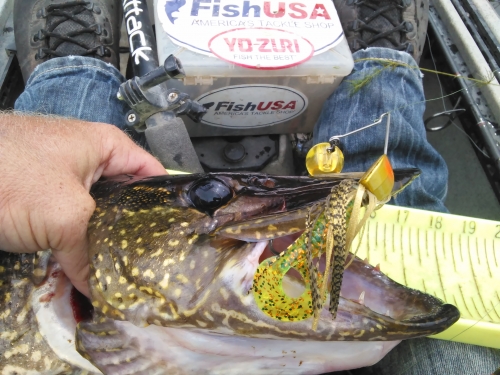
Fishing for large northern pike during summer can be daunting at times, but they can still be caught with relative frequency. Throwing the Knuckle as a change-up to patterns used in spring and fall can be a terrific way to keep you on the numbers and good-sized fish.
Western Striper Success!!! -by Manuel Saldana Jr.
The Striper fishing out in the west coast is on FIRE!!!! Want to increase your chances at have a day on the water that will make memories for a lifetime, here is some helpful tips on what I prefer to do and the set up I rely on!
My rod and reel choices are the following:
Rod is a 7’6″ heavy in power with a fast action tip.
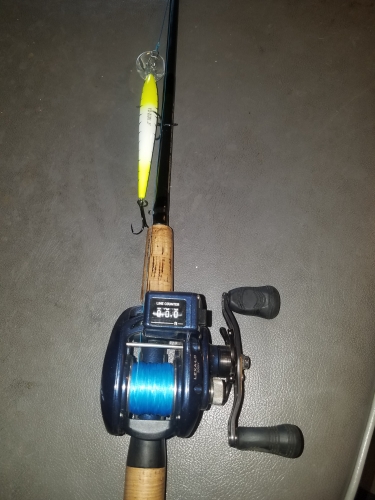
The reel is a 300 size conventional reel with a line counter. Line counters are a must because this helps us out as a guide to know how far everyone’s line or lures are.I prefer to spool it up with 30lb Yo-Zuri SuperBraid in the Blue color pattern.
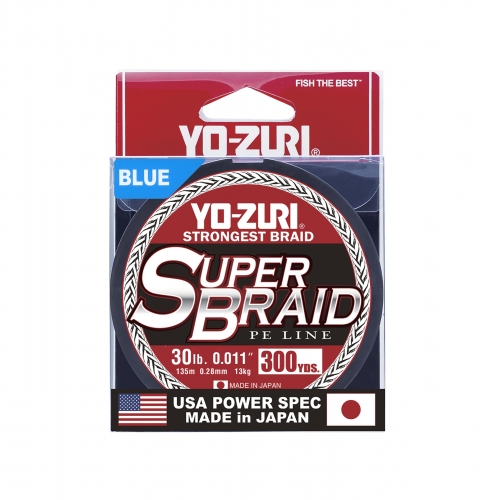
Weather conditions that are most favorable are Mid-March thru early summer, but this year throughout April and May the weather was normal morning temp 45 degrees and a high temp of 74 degrees throughout the day but the main issue we have faced is the water temperatures of 50 to 52 degrees. Our normal water temperatures are 55 degrees in mid-March and approximately 60 degrees in mid-April. It took a while to figure it out, we had Spring weather temperatures but winter water temperatures due to all the snowpack in the Sierra’s.
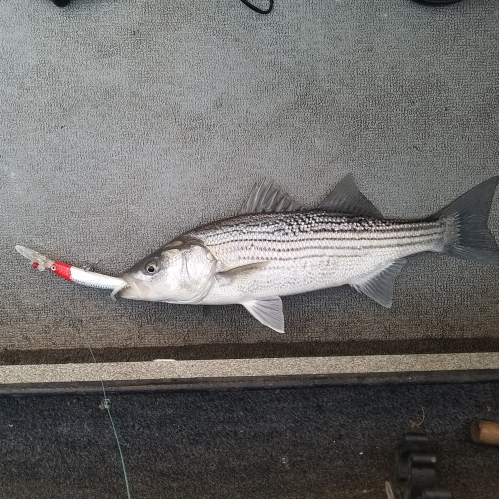
Most effective techniques were drifting upstream with deep diving floating Yo-Zuri Crystal 3D Minnow lures or the Yo-Zuri Crystal Minnow Deep Diver Walleye series lure. I recommend trolling upstream at 3 to 4 MPH. Trolling at higher speeds make these stripers react to our lures, and with the colder water temps you had to get the lures right in their face because they were lethargic.
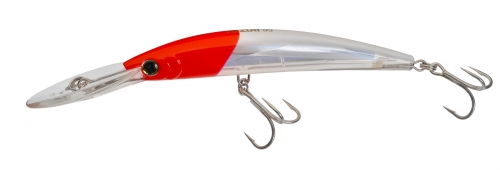
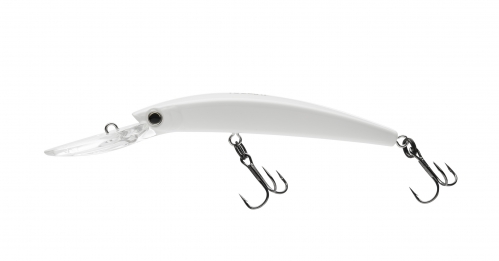
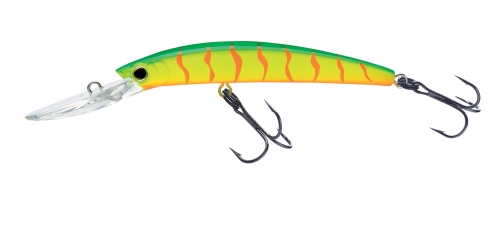
Hot baits were the standard deep diving floating Yo-Zuri Crystal 3D Minnow in Redhead/White body. This lure, for many years, has been the ‘go-to’ it comes to catching stripers. In the freshwater Deep Diver Crystal Minnow Walleye series lures the solid white has been hot for us. The bite is so good that it is almost like the stripers have never seen this lure before and they flat out couldn’t resist it! I believe the very tight wiggle the Crystal Minnow action has in the water mimics most live bait in many bodies of water such as Shad, or Pike Minnow. Another hot suggestion is the Deep Diver Walleye Series in the Hot Tiger color.
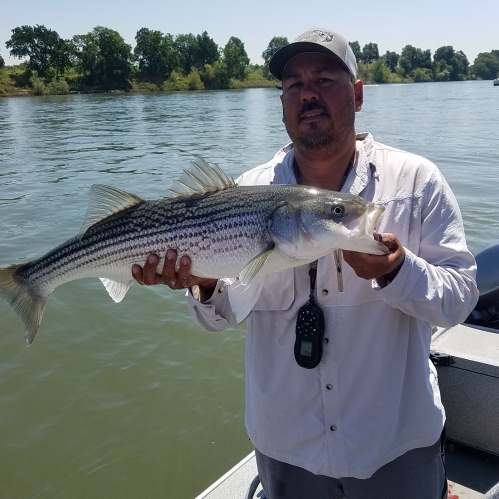
One tip I can pass on to anglers that will help them be successful is to remove the split ring that comes in the package tie a size 54 duo snap lock to your braid the attach it directly to the bait. This helps the lure run true, plus it makes easier to change out your lures as well. Also, make sure you add a trailer worm to your trailing center hook; it helps the lure get an even tighter wiggle.
Walleye Season 2019 is FINALLY Here!!! by Marc Tremblay
This week marks the start of the 2019 Walleye season up north and we checked in with Yo-Zuri Prostaff angler Marc Tremblay in how he attacks early season.
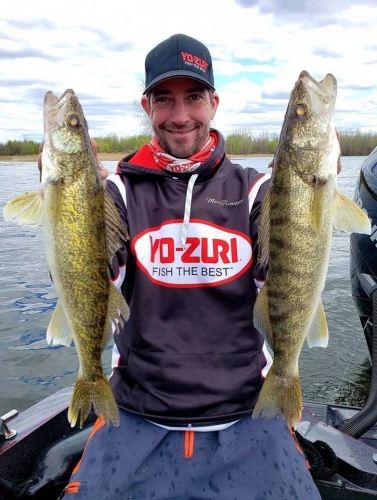
Primary Technique: Yo-Zuri Crystal Minnow Walleye DD
Marc always starts with when early season walleye fishing is trolling a Yo-Zuri Crystal Minnow Walleye Deep Diver in a shallow area (rock structure-weed line-edge of pool)

“I try to put the bait very close to the bottom. The fish are often relating to a rocky bottom because the the most heat will be held here. Typically if I am not hitting the bottom then I am not in good position to get bit”, says Marc.
The trolling speed in cold water is around 0.8 and 1.2mph, this allows the Crystal Minnow Walleye DD to have great action while not being too fast. The walleye are cold and lazy after the ice melt and may not seem as aggressive as they will be in a month.
Marc prefers a seven foot trolling rod medium heavy extra fast action. This rod also the bait to work the best action and is not too stiff whenever a walleye bites.
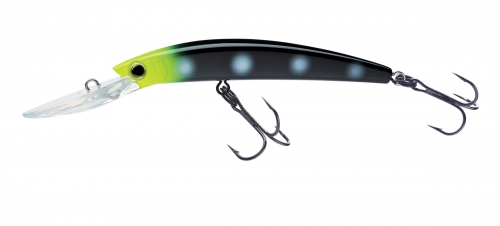
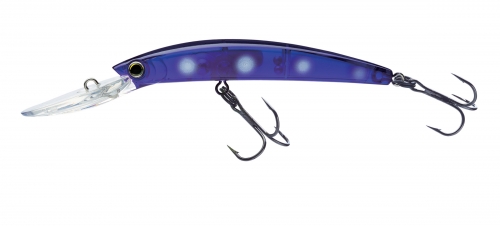
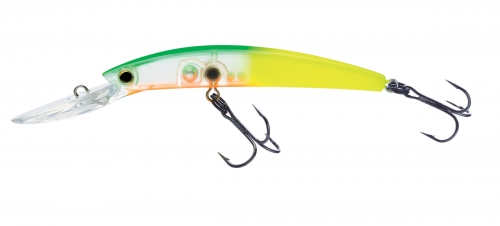
“I use Yo-Zuri SuperBraid 20 pound. I prefer the smaller diameter to help the lure to go to the bottom faster and less restriction. I also tie on a 6 foot Yo-Zuri TopKnot Mainline fluorocarbon leader. My method to the madness is simple: Dark color in cloudy water (Zombie, Midnight) and light color for a sunny day.”
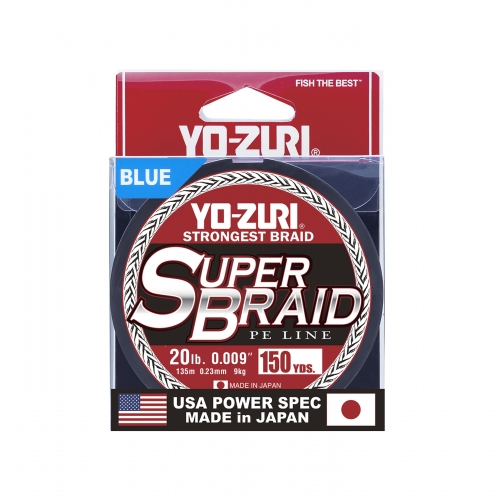

Secondary Technique: Jigging a Rattl’N Vibe
Marc mostly uses conventional jig equipment with a Yo-Zuri Vibe, preferably the 1/2oz size.
“I prefer this technique when fishing around a lot of current. The tight wobble and loud sound of the Vibe seems to really make a difference. I use a 6 foot heavy jigging rod with 10 pound SuperBraid mainline and 8 pound HD Carbon leader.”

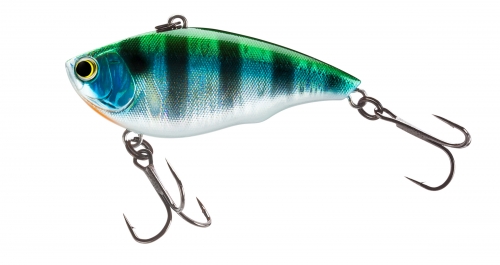
Marc says for the best action to use the bait without a clip and try to fish in areas where there is a discrepancy in the current. Finding a small calm current break can be the most successful. The walleye this time of year again are lazy and would rather find areas in current where the bait will naturally appear in their face without having to chase it down. This also means not being afraid to make multiple casts.
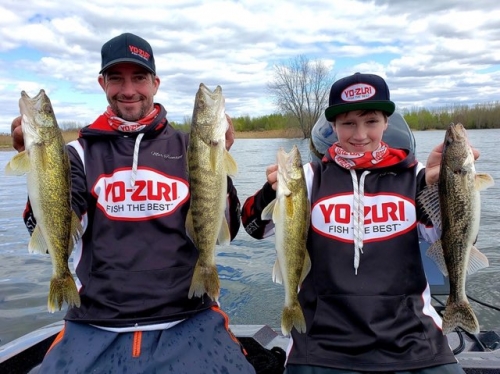
Yo-Zuri Prostaff angler Brandon Cobb Captures his first W
 Fishing as a professional bass fisherman comes with a lot at stake. It can be financially trying, emotionally exhausting, physically demanding, but can all pay off when the plan comes together. Every angler out there has one goal in mind; to WIN! But what if you are in front of your hometown crowd? The people that saw you grow-up, the friends you’ve known your whole life, your wife, your parents and grandparents, all your family, what if you were the angler everyone had their eye on through-out the week? Does the stakes of winning get higher? Is there more added stress? Do you expect more from yourself? Well that was exactly the cards dealt to Yo-Zuri Prostaff angler Brandon Cobb last week on Lake Hartwell for the Bassmaster Elites Series event in South Carolina.
Fishing as a professional bass fisherman comes with a lot at stake. It can be financially trying, emotionally exhausting, physically demanding, but can all pay off when the plan comes together. Every angler out there has one goal in mind; to WIN! But what if you are in front of your hometown crowd? The people that saw you grow-up, the friends you’ve known your whole life, your wife, your parents and grandparents, all your family, what if you were the angler everyone had their eye on through-out the week? Does the stakes of winning get higher? Is there more added stress? Do you expect more from yourself? Well that was exactly the cards dealt to Yo-Zuri Prostaff angler Brandon Cobb last week on Lake Hartwell for the Bassmaster Elites Series event in South Carolina.
How did Brandon do? He never even flinched and got the job done; winning his first Bassmaster Elite Series event in his career and taking home a $100,000 payday.
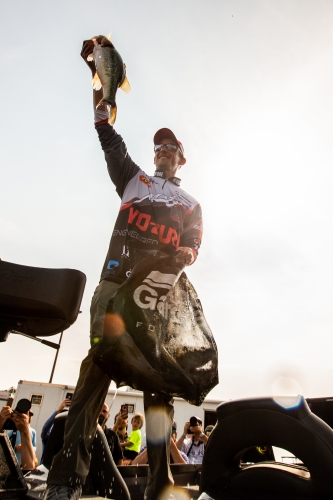
Brandon grew up in South Carolina and has fished Lake Hartwell his whole life, so knowing the lake was no problem. Making sure he didn’t let history interfere with his ability to fish clean and strong to capture the win; that was the difficult task. The Yo-Zuri pro knew he needed to stick to one area of the lake that was notorious for big bedding fish. He stuck to his plan and stayed calm.
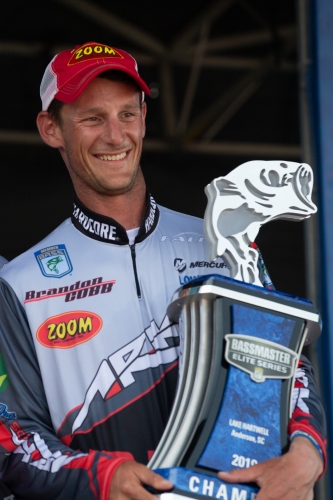
Brandon is a well-known angler that prefers to burn the bank and cover as much water as he could throwing moving baits. But, when the springtime hits and water is clear; the best way to catch them is with a spinning rod. Brandon threw a wacky worm throughout the tournament but still managed to cover as much fishable water as he could, even at times revisiting areas through-out the tournament days as fish continued to move up in his primary areas.
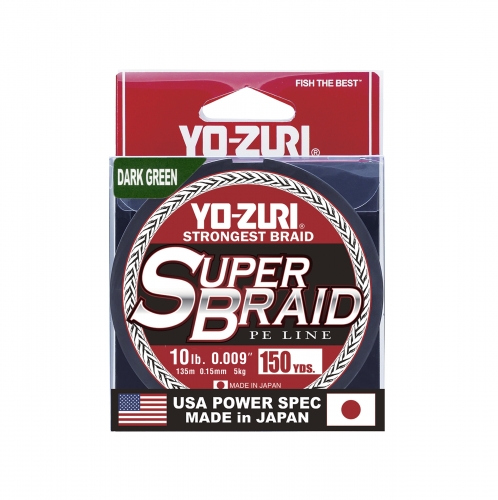
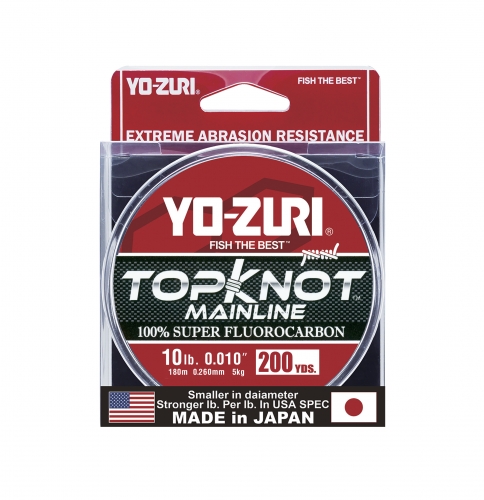
Brandon’s arsenal of attack was a 6’10 medium action spinning rod, 2500 size spinning reel, Yo-Zuri 10lb SuperBraid with a 10lb Yo-Zuri Topknot Fluorocarbon leader. Brandon was using this set up to throw a wacky worm to make long casts and catch cruising largemouth in bedding areas. Occasionally he would slow down and throw a shaky head for fish that were locked onto a bed, but most of the fish he weighed in were cruising shallow.
Spring is Coming and that Means….OPEN WATER!!!
 One of the best times of year to catch Northern Pike is in the post-spawn and early spring when water temperatures warm to 45-55 degrees. The post-spawn and early spring is one of those special times of the year when you can land some of the largest Northern Pike of the open water season. Gold, Silver, and Bronze Yo-Zuri hard baits are all Olympic winners when chasing big Pike during this time.
One of the best times of year to catch Northern Pike is in the post-spawn and early spring when water temperatures warm to 45-55 degrees. The post-spawn and early spring is one of those special times of the year when you can land some of the largest Northern Pike of the open water season. Gold, Silver, and Bronze Yo-Zuri hard baits are all Olympic winners when chasing big Pike during this time.
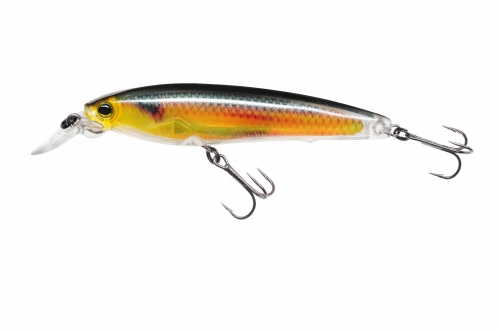
Gold: One of my favorite “go-to” lures during the post-spawn and early spring for Northern Pike is the Yo-Zuri Golden Shiner 3DR Jerkbait. The Jerkbait is a lure that that works especially well for Northern Pike during this time of year because it can be effectively twitched in 2-5’ of water which they often frequent. Old bulrushes, rock and sand points, and shallow bays are all prime spots to try with the 3DR Jerkbait.
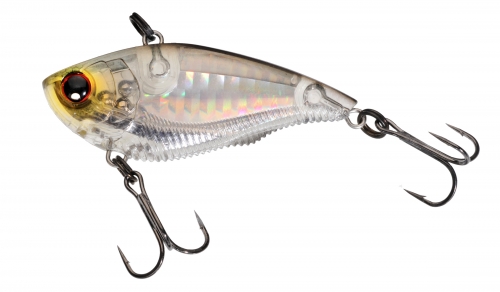
Silver: Another great option during the post-spawn and early spring for large Northern Pike is the Yo-Zuri Prism Silver Black 3DB Vibe. The Prism Silver Black Vibe works great when fished with a sporadic cadence along the first drop-off in a lake. The drop-off approach with the Vibe gives large Northern Pike a perfect vantage point for ambushing bait with minimal effort to feed. Ideally, I look for drop-offs in the 5-8’ range so that I can let the lure sink as needed to generate reaction strikes. It may be necessary to go this route when fish are lethargic and not yet feeding heavily due to recent spawning activity.
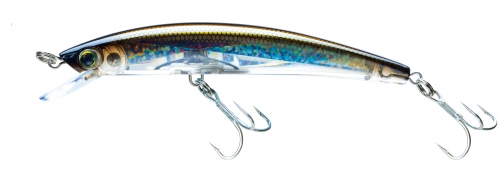
Bronze: The last lure choice that I want to discuss which I rely on for large post-spawn and early spring Northern Pike is the 4 3/8” Yo-Zuri Holographic Bronze Shiner Crystal Minnow (Floating or Suspending). One of my favorite ways to fish the Holographic Bronze Shiner Crystal Minnow is to use it as a search bait via trolling. When trolling the Crystal Minnow from my kayak, I change paddling speeds frequently and twitch the rod occasionally to emulate an injured or dying baitfish. Trolling with the Yo-Zuri Crystal Minnow works great on flats as shallow as 4’, the first drop-off from a bay, and points that drop into 10’ or more of water.
Choosing a Yo-Zuri Jerkbait, Vibe, or Crystal Minnow can be a great way to increase your odds of catching more fish. Go for the Gold, Silver, or Bronze during the post-spawn and early spring and you may end up netting your largest pike of the open water season.
Late Winter Offshore Mahi Bite Picking Up!!! –Matt George
 Matt George, one of the craziest but respected personalities to the Yo-Zuri family. Matt grew up in the northeast US, but has called Florida home for several years now. When not traveling for business all over the world, he spends his down time wisely fishing inshore and offshore.
Matt George, one of the craziest but respected personalities to the Yo-Zuri family. Matt grew up in the northeast US, but has called Florida home for several years now. When not traveling for business all over the world, he spends his down time wisely fishing inshore and offshore.
“To me, I don’t care what I am catching as long as I am on the water. But lately the offshore bite has been really picking up. Following a strong pattern lately is turning into more success on the water. Let the birds help you find the bait, let the bait be your GPS, and bring on the exhilarating fight that lies before you.”
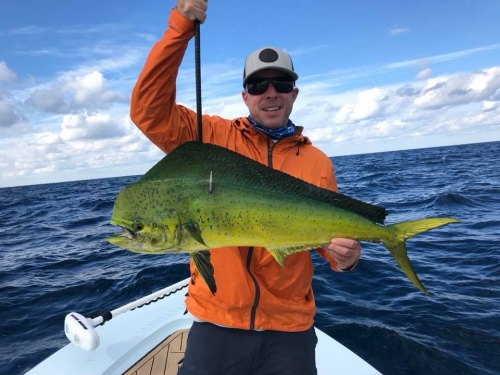
Recently, Matt is spending more time chasing the offshore bite as it is picking up. As winter is coming to a close in south Florida, the bait abundance is increasing and so is the bite.
“Right now I am hitting the water as early as possible and making a 8-12 mile run out. The key depth is anywhere between 100-200 feet. That may seem like a lot, but in your search for lurking Mahi it is easy to eliminate water quickly. Once you find that sweet spot, it is all easy pickings at that point.”
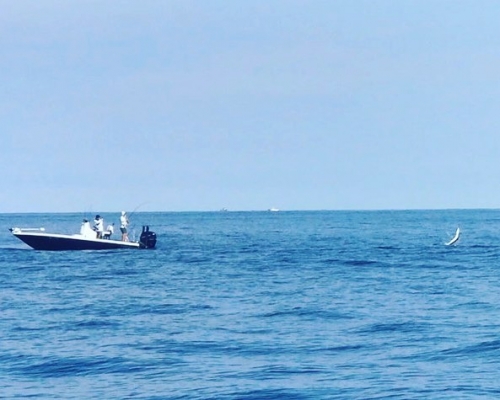
To duplicate what Matt is doing, you have to find the water that will most likely have bait, again Mahi have huge appetites and are predators. Once you find the bait you can find the fish. Along with the right amount of depth, Matt suggests looking for the temperature changes. This little subtlety could be key, but also the any irregularities in the water. Weed lines, cleaner water, dirties water, whatever may appear different out in the ocean could be the ticket. From there just find the bait which is usually accompanied by diving birds.
“The added bonus right now is on top of the Mahi I am catching, I am also finding a mix of Sailfish, again one of favorite species to target. Recent trips I am averaging 3-4 keeper Mahi and about the same number of sails. The days out there have been really fortunate and exciting!”

Matt is using a 2-way approach to targeting his catch. The traditional trolling method and topwater have paid off the best. For the trolling methods, he is rigging live bait on 30lb Yo-Zuri Blue SuperBraid with 30lb TopKnot Fluorocarbon Leader. The topwater he has been using is the Yo-Zuri Hydro Popper on a spinning outfit with the same line and leader. For the popper, Matt emphasizes to always use a loop knot when adjoining your leader to a topwater bait. This always creates the best action on the water.
FLW Tour Lake Toho Top-20 Finish Recap- by Mike Surman
 The older I get in this sport the more a good finish means to me. With the changing technology, industry curves, and constant new talent making their way into the tour level; the harder it is for me compete against fellow anglers. However this past weekend in my current home state of Florida at Lake Toho, Mickey Mouse must have given me a little magic being so close to Disney World because everything came together.
The older I get in this sport the more a good finish means to me. With the changing technology, industry curves, and constant new talent making their way into the tour level; the harder it is for me compete against fellow anglers. However this past weekend in my current home state of Florida at Lake Toho, Mickey Mouse must have given me a little magic being so close to Disney World because everything came together.
The fishing in Florida has been really off so far this year. Between the low water in all the lakes, the Red Tide issues the entire state faced last year, and it still being early in the year the best fishing is still yet to come. This last week I was really able to pinpoint a good amount of fish that were pre-spawning and spawning. I used my local knowledge of the lake to lock into Lake Kissimmee and fish staging areas leading into spawning areas with good, healthy grass around it. With water temperatures in the mid-60s I knew as the week processed the fish would continue to move up.
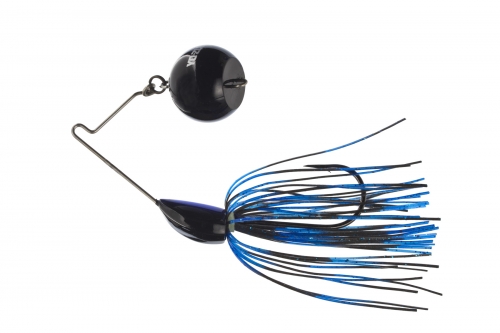
In practice I was really able to capitalize on a morning pattern and then an afternoon pattern, a key to my success knowing I could stay calm throughout the day and capitalize on the different patterns when they were at their best. In the mornings I was catching fishing on a 1/4oz Black and Blue 3DB Knucklebait with a soft plastic swimbait trailer. I was able to catch a couple really good fish on this and thought it would be a key bait for me throughout the tournament. I was throwing the Knucklebait over submerged grass around staging areas. As the afternoon took place and the sun got high I was able to pitch to hydrilla mats and dollar pads with a soft plastic stickworm catching spawning fish.
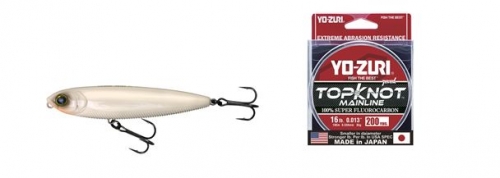
In the tournament, the morning Knucklebait bite had died but I was still able to capitalize catching these same fish using a 3DB Pencil in Bone color. For this technique I was throwing 20lb Yo-Zuri Hybrid line, and I was making short casts with it. I think the bait has better action when making shorter casts and not having so much stretch in the line. In the afternoons I was able to again capitalize again on the plastic stickworm bite. I was fishing the worm on a little [1/16oz] weight and throwing it on 16lb Yo-Zuri TopKnot Mainline Fluorocarbon.
One of the last factors that helped me was covering water in an area. I was fishing a massive area of Lake Kissimmee and it seemed like covering water and then breaking down an area once I got a bite was the key to capitalizing on water holding fish.
